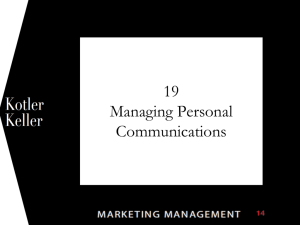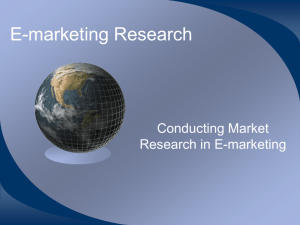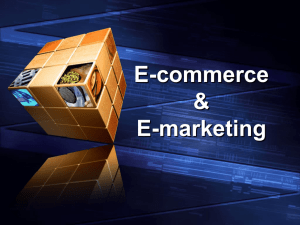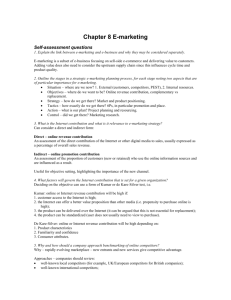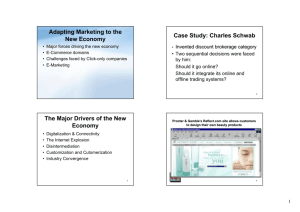Ethics, Global Marketing & The Internet 1
advertisement
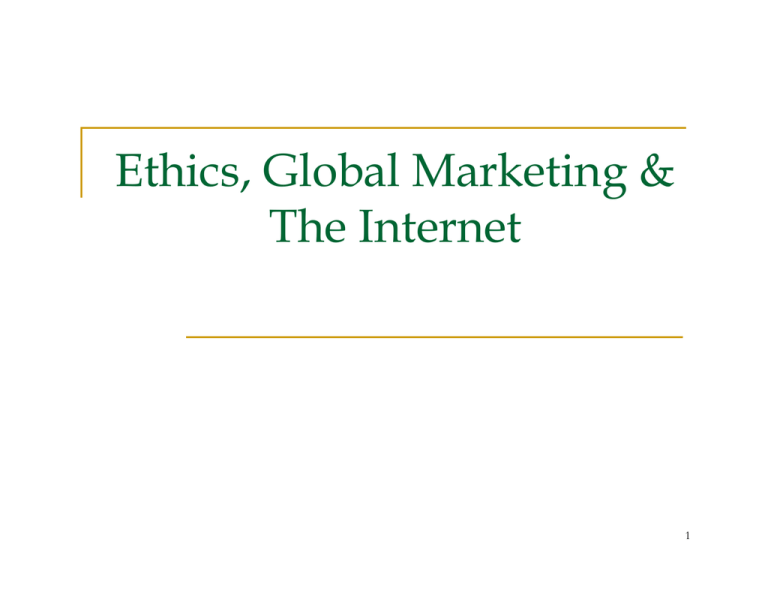
Ethics, Global Marketing & The Internet 1 Ethics and Social Responsibility • Social Responsibility – – • Maximize its positive impact on society Minimize negative impacts Corporate Social Responsibilities – – – – Economic Legal Ethical Philanthropic 2 Ethics and Social Responsibility • Marketing Ethics – – – – Principles and standards that define acceptable marketing conduct as viewed by the various stakeholders Beyond legality Foster trust Builds long-term relationships 3 Ethics and Social Responsibility • Social Responsibility Issues – The Environment – – – – • Green Marketing Environmental friendly Avoids waste Community relations and corporate citizenship Ethical Issues – – Found in each of the 4 Ps Complex decision-making process 4 Ethics and Social Responsibility • Improving Ethical Conduct – – – – • • Eliminate unethical employees Create a Code of Conduct If large enough, utilize an Ethics officer Implement compliance programs Not easy to do Often improves marketing performance 5 Global Marketing 6 International Markets • Forces that affect International markets – Environmental Forces – – – – Cultural Social Ethical Economic Forces – – – Tariffs Embargoes Quotas 7 International Markets • Forces that affect International markets – Political and Legal Forces – – – Common practices (payoffs) Governmental attitudes Technological Forces – Advanced versus developing countries 8 Trade Agreements • NAFTA – – – • • • Mexico and Canada Highly controversial Plenty of phase-in time APEC (Asia-Pacific Economic Cooperation) GATT (Gen Agreement/Trades & Tariffs) WTO (World Trade Organization) 9 International Approaches • • Importing and Exporting Trading Company – • • • • Like a broker or agent Franchising or licensing Contract Manufacturing Direct Ownership Joint Ventures – Strategic Alliance 10 Internet Marketing 11 E-Marketing • • Done in the virtual environment of the internet Key Benefits – – – – – – Marketers and customers share information Feedback opportunities Lower cost of communications Rapid response Decreased operating expenses Reduced geographic barriers 12 Characteristics of E-Marketing • • • • • • Addressability Interactivity Memory Control Accessibility Digitization 13 Characteristics of E-Marketing • Addressability – – – The ultimate expression of the marketing concept Ability to identify customers before they make a purchase “Cookies”: identifiable tracking device, allows for more customization 14 Characteristics of E-Marketing • Interactivity – – – Customers have the ability to tell you what they want Real-time communications at lower cost Concept of “community” – belonging to the group 15 Characteristics of E-Marketing • Memory – – – Ability to access database profiles Creation of specific, customized offers Allows for better inventory management 16 Characteristics of E-Marketing • Control – – – – Ability of customers/prospects to determine their information absorption – amount, rate, sequence Web is a “pull” medium; website visitor controls the viewed content Attracting and retaining prospect’s attention much more difficult Hypertext and links are critical 17 Characteristics of E-Marketing • Accessibility – – – – Ability to gather information Increases the competition Brand equity, brand awareness, and name recognition more important The website address (URL) – Uniform Resource Locator 18 Characteristics of E-Marketing • Digitization – – – Ability to represent a product or its benefits as digital bits of information For example: customer histories, tracking capabilities Quick and inexpensive modifications 19 E-Marketing Strategies • Target Markets – – – – Selected more precisely Relationship building a must, CRM Loyalty and retention critical Lifetime Value of a customer 20 E-Marketing Strategies • B2B – – – – Growing faster than any other segment Improves timeliness and reliability Reduces uncertainties Helps companies manage production output 21 E-Marketing Strategies • B2C – – • Very small percentage of retail sales More comparison shopping than actual purchasing C2C – – eBay Auctions and bartering 22 Product Issues • • • Brand recognition will be more important in marketing of services on the internet Products with unique benefits will be successful Customized products with highly competitive pricing also should “win” on the internet 23 Distribution Issues • • • • Inefficiencies reduced Better supply chain management and relationships Lower distribution costs lead to better profitability Typically, customer satisfaction is greater 24 Promotion Issues • • • • Tie-in traditional campaigns with webbased promotions Better opportunity to convey / communicate a stronger feature/benefit message A good source for customer feedback (research) through dialogue Can be much more effective, but tougher to attract the browser 25 Promotion Issues • Key Advertising Terms – – – – – Banner ads: small, rectangular ads at top of web page; can be animated or static Keyword ads: relate to a specific subject matter in a web search Button ads: small ads, typically squares or rectangles; often just a brand name or logo Pop-up ads: “hated”; larger ads with more content that open a separate window Sponsorship ads: brands/products combined with editorial content 26 Pricing Issues • • • • Customers have more access to cost and price information Results in more comparative shopping Internet best for price-driven competition Low cost of internet promotion can generate lower prices 27 Legal & Ethical Issues • • • • Personal Privacy Spam Trademark infringement Stealing of copyrighted materials 28

